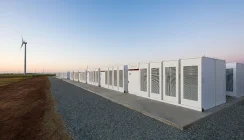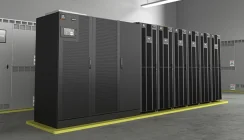Datacentre Energy Storage Systems Build on Micro Grid Technologies
Micro grid technologies were originally designed to allow sites to become grid independent. A typical site has a solar PV or wind turbine installation, some form of battery to store the locally generated energy and an inverter to convert the stored DC energy into an AC supply for the connected loads. The site may also have a local diesel standby power generator. This type of energy storage arrangement is one that can benefit both datacentre and national grid operators.
The Role of An Uninterruptible Power Supply
The original purpose of uninterruptible power supplies was to provide both power quality protection when a mains power supply was present and standby-battery power for power outages. Power quality refers to the generation of a clean and stable output waveform clear of power pollution including brownouts, sags, surges, spikes, transients and harmonics. Currently the most common battery-type for a UPS system is a lead acid battery.
In a server room or datacentre environment UPS systems provide protection of the critical power path from the building income to power distribution units (PDUs) and their connected IT servers and network equipment. The critical power path may also have emergency standby power in the form of a local generator. The arrangement is like that of the energy storage system design used within a micro grid.
Power quality has improved over the last 20-30 years within many European countries. The switch mode power supply (SMPS) at the heart of IT servers and modern electronic equipment has also become more robust and supply tolerant. This means that the UPS system is principally providing an ‘energy storage’ role for emergency back-up in for many typical applications.
Grid Scale Energy Storage
The greatest challenge faced by many national grid operators is how to provide enough uninterrupted power to meet the demands of the countries and regions they serve. Power usage within Europe and the US is increasing for several reasons: population growth, demand for datacentre-based services and the move to a low carbon economy via electrification i.e. the shift to electric vehicles.
In the UK the National Grid has introduced several programs and initiatives to help balance out demand and maintain a stable supply frequency. Known as demand side response (DSR) the programmes are designed to change the use of electricity by end-users in order to balance out demand and provide the end-users with initiatives to do so. Grid scale energy storage systems are also being trialled to provide a ‘fill-in’ and reduce the load on the grid during peak times. DSR programmes include large scale energy users reducing their power demand at peak times, providing support to the grid from their local standby generating sets and the use of stored energy within grid-scale battery packs.
More info: https://www.nationalgrideso.com/balancing-services/demand-side-response-dsr
Datacentre Energy Storage
The enormous amount of power drawn by datacentres provides an opportunity for their operators to take part in DSR initiatives using their local uninterruptible power supplies as potential revenue generators. Turning a UPS system into an energy storage system for DSR requires a change in overall configuration and battery technology. The configuration consists of using the UPS as a virtual power plant or as a generator of power and feeding this back into the grid.
Virtual Power Plants
A virtual power plant is another term for a micro grid. In the VPP role, the uninterruptible power supply uses its battery set as its prime power source and the mains power supply and any local standby power generator as back-up. The battery is charged during off-peak periods, when electricity prices are cheapest is used to power the load during peak periods or when the load is taken off-the-grid as part of a DSR program.
Lithium Battery Pack Technology
The traditional battery for energy storage has used lead acid technology. Advances in lithium batteries and especially lithium-ion are leading to a wider adoption of energy storage in both commercial and residential applications. Lithium provides several advantages of lead acid batteries. They are more temperature tolerant, pack a higher power density and are capable of almost unlimited charge and recharge cycles. Lithium batteries also recharge more quickly than lead acid. Using lithium-ion batteries within datacentre energy storage systems provides several benefits:
- The datacentre can take part in peak-shaving to support grid DSR programs
- Locally generated renewable energy can be stored within the battery pack
- The UPS system can be used to generate power to sell back to the grid
- The datacentre can become grid-independent operating its own micro grid
- Diesel generator usage can be reduced thanks to a faster recharging battery set
- Less reliance on lead acid batteries and the development of lithium technologies
Lithium-ion batteries are the type of battery used within electric vehicles and are the primary choice over lead acid for energy storage type applications. Their use with a UPS system requires a different type of battery management and charging system and several UPS manufacturers now offer this type of arrangement for datacentres and buildings in general.
More info: https://www.eaton.com/gb/en-gb/catalog/energy-storage/xstorage-buildings.htm
Supplying Power to The Grid
This approach may not suit every type of datacentre and the Uptime Institute is looking into how this usage may affect its Tier-rating program in terms of resilience. An uninterruptible power supply is installed with a battery set to provide a specified duration of battery power to the local load. In ‘supply mode’ energy from the battery is sold back to the grid limiting the amount of available runtime for local loads.
This type of arrangement is very similar to that used for local standby generating sets taking part in DSR programs. The facility must have a local override and choice as to whether to participate in the DSR when called upon to do so and without placing a greater risk on the local datacentre. For those datacentres with an A and B supply or unused uninterruptible power supplies supplying power to the grid may be more attractive. The datacentre could use its ‘B’ leg for DSR revenue generation or decide to recommission old UPS systems with a new lithium-ion battery pack.
Summary
Lithium-ion battery technologies are changing the application roles for UPS systems and are the battery of choice for energy storage systems. In comparison to lead acid the only downside is their higher initial cost and the fact that they are less environmentally friendly at their end of life in terms of recycling and material re-use. Within the next 5-10 years most UPS systems installed will use lithium batteries and this opens a few potential roles for the UPS including use as virtual power plants and within grid supporting roles. Developments in artificial intelligence and smart grids should help to automate this process ensuring that datacentres are protected, and grid demand is available for all power consumers.


























